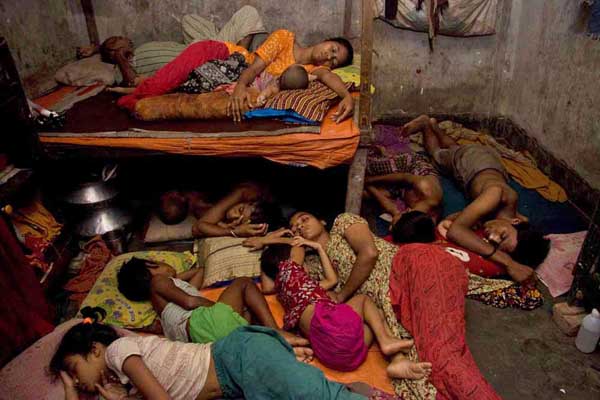Pathshala alumni Taslima Akhter shortlisted in AnthropoGraphia

|
The 4th edition of the AnthropoGraphia
|
|
Shattered myths, Violence against women in Norway
by?Walter Astrada?from Argentina
|
|
Over the last weekend of July 2012, Tina Ahrens, co-founder of Emphasis, James Estrin, founder of the New York Times? Lens blog and Matthieu Rytz, founder of AnthropoGraphia reviewed the submissions sent in by impressive candidates. This team carefully narrowed down the entries to 12 photo-essays and 6 multimedia projects. From these, one outstanding photo-essay and one outstanding multimedia project was chosen as the recipient of this year?s award as well as two honorary mentions.
|
|
“There was a lot of excellent work entered for ?AnthropoGraphia this year.
I think it is vitally important to recognize photographers who have devoted large parts of their lives to addressing human rights issues. The winner, Walter Astrada, has spent years documenting violence against women around the world. His latest installment, from Norway, shows the pervasiveness of this violence, even in a society that is thought to be relatively safe. The images are subtle but powerful.
One thing that Tina Matthieu and myself appreciated was how many entrants were trying to develop different visual approaches to telling stories about human rights. We are all bombarded with images every day and It is important to find new strategies to ?visually communicate these concerns.
I’m grateful for ?AnthropoGraphia’s ?continuing support and promotion of ?photographers working on human rights issues.”
James Estrin
editor and founder of the
New York Times Lens blog
|
“Any advocacy work that aims to change things has to start with awareness. Photography is a very powerful tool to raise awareness and shed light on underreported issues.?This is why it is very important to have a specific award that recognizes the work of those photographers who are dedicated to reporting on human rights? abuses and who advocate human rights.
In our selection of this year?s winners, we took into account a photographer?s dedication to an issue, we recognized photographers? efforts to document issues in their own countries, we looked for a diversity of backgrounds and approaches, and we were interested in issues of representation : how are those affected by human rights? abuses portrayed in the pictures? Is the photographer also seeing the individual who is affected or is he/she just showing “the victim”.
AnthropoGraogia?s exhibition consists of powerful and important bodies of work. However, this year?s winner, Walter Astrada, stood out thanks to his outstanding commitment to documenting violence against women around the world. His selected work on domestic violence in Norway, one of the supposedly safest countries in the world, shows us that human rights abuses do not just happen in far away countries, but are at times hidden and present where we least expect them.”
Tina Ahrens
co-founder of emphas.is
|
“AnthropoGraphia aims to raise general awareness of human rights issues which traditional media too often marginalize and Walter Astrada?s series on violence against women in Norway fits perfectly for the Human Rights through Visual Storytelling Award with this important forgotten issue.
AnthropoGraphia also strives to push others besides Western European and North American male photographers, and this year we have reached that goal more than ever. Taslima is a Bangladeshi photographer and her work speaks about the Life & struggle of women workers in Bangladesh. Dalia Khamissy from Lebanon received an honorary mention for a multimedia presentation on the consequences of the Lebanese civil war. Zhang Lijie from China focuses on misdiagnosis, lack of medicine, poverty and discrimination of Chinese citizens suffering from rare diseases.
This 4th edition witnessed human rights abuses around the world through the eyes of visual storytellers that commit themselves to telling human stories to the world with passion, sensibility, truth, sacrifice, and too often with little money. AnthropoGraphia opens up space for them to speak with their visual stories to give a voice to the victims of human rights abuses.”
Matthieu Rytz
Founder of AnthropoGraphia
|
|
photo-essay
|
winner
Shattered myths, Violence against women in Norway
Walter Astrada?from?Argentina |
Norway, according to the Global Peace Index, is one of the safest countries in the world, and among the wealthiest. It is, however, not the safest for women.
From 2000 to 2010, 83 women were murdered by their partner or ex-partner.
Every year more than 3000 women and 2000 children have to spend the night in a shelter.??60 % of the women who stayed in the shelters in 2008 had immigrant background. 28 % of these were married to Norwegian men. 7 of 10 rapes are committed in private homes.
The exact extent of domestic violence against women and children in Norway is not known, but a number of studies clearly indicate that such violence is far more widespread than initially thought.
|
|
honorary mention
|
honorary mention
|
|||
 |
 |
|||
|
Sleeping with the Devil,?Fort McKay, Alberta, Canada
Aaron Vincent Elkaim/Boreal Collective?from?Canada |
Transmongolian,?Mongolia
?lvaro Laiz?from?Spain |
|
shortlist
|
 |
 |
|||
|
The Life & struggle of Garment Workers,?Bangladesh
Taslima Akhter?from?Bangladesh |
The TB epidemic in Ukraine,?Ukraine
Maxim Dondyuk?from?Ukraine |







Leave a Reply
You must be logged in to post a comment.